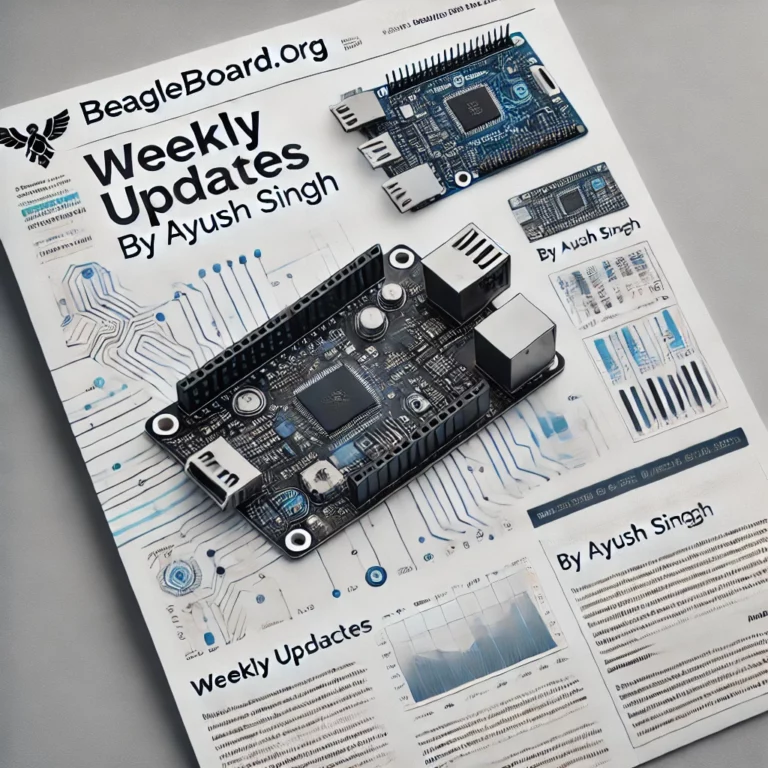Hello everyone. Since PocketBeagle 2 has launched, most of the development was focused on it. Let’s go over everything.
Enable Greybus BeaglePlay driver in defconfig
As per suggestion of Nishanth Menon, I have added gb_beagleplay to the defconfig. Here is the latest version of the patch.
Export Symbols RFC
As alluded to in my prior posts, I have been working on using export-symbols in devicetree to add support for add-on connectors such as MikroBUS. This was first proposed by Herve Codina in the following Linux kernel patches. Since then, I have sent patches to add support to devicetree compiler and fdtoverlay.
The overall goal is to make export-symbols part of devicetree specification instead of just a Linux specific extension. This is to allow sharing of add-on board overlays with ZephyrRTOS, which has boards like BeagleConnect Freedom with support for MikroBUS.
To that end, I have sent an RFC in the devicetree specification mailing list to see if anyone has any objections/flaws to point out. I will be sending a patch adding the node to the specification in a week or 2, if there are no objections.
PocketBeagle 2
PocketBeagle 2 is now available for purchase. While, everything is mostly working now, I have been working on adding a few things to just make the support as good as possible.
Debug Port
In the early phases of development, most people were using PocketBeagle® TechLab with PocketBeagle 2, and thus using the UART exposed by it. However, PocketBeagle 2 has a debug UART (compatible with Raspberry Pi Debug Probe) on board.
There were some issues to get U-Boot working with this UART, but other than U-Boot R5 logs, everything is redirected to use the Debug Port. We are actively working on getting R5 to also use the debug port, but it should not affect general usage, since the boot selection menu is shown by A53 core.
Examples
In a recent discussion, it was also decided to add examples for beginners to get started quickly. Initially, I was going to use Python, but given that Beagle Boards seem to attract a lot of people in Kernel and U-Boot space, it was decided that I should go ahead with writing examples in Rust.
With Rust support in Linux kernel finally reaching a good enough state, this means the same language can be used for both userspace IoT projects and Kernel space drivers.
Rust is also quite popular nowadays, so it might help attract new potential contributors. The examples can be found here. Hopefully, they will start being shipped in default images, and will be accessible with the Theia local Theia editor.
Feel free to create issues regarding the examples you would like to be added.
Hello Beagle
Simple example to test that Rust has been set up correctly.
Usage
debian@pocketbeagle2:~/vsx-examples/PocketBeagle2$ cargo run -p hello_beagle
Compiling hello_beagle v0.1.0 (/home/debian/vsx-examples/PocketBeagle2/hello_beagle)
Finished `dev` profile [unoptimized + debuginfo] target(s) in 5.64s
Running `target/debug/hello_beagle`
Hello, World! From PocketBeagle2
EEPROM
Read and parse EEPROM contents in Rust.
Usage
debian@pocketbeagle2:~/vsx-examples/PocketBeagle2$ cargo run -p eeprom
Compiling eeprom v0.1.0 (/home/debian/vsx-examples/PocketBeagle2/eeprom)
Finished `dev` profile [unoptimized + debuginfo] target(s) in 3.99s
Running `target/debug/eeprom`
EEPROM Data: Contents {
magic_number: [
170,
85,
51,
238,
],
hdr1: Header {
id: 1,
len: 55,
},
hdr2: Header {
id: 16,
len: 46,
},
board_info: BoardInfo {
name: "POCKETBEAGL2A00G",
version: "A0",
proc_number: "0000",
variant: "0G",
pcb_revision: "0G",
schematic_bom_revision: "A0",
software_revision: "00",
vendor_id: "01",
build_week: "34",
build_year: "24",
serial: "PB20000001",
},
hdr3: Header {
id: 17,
len: 2,
},
ddr_info: 4776,
termination: 254,
}
Blinky
Simple example to toggle GPIOs. Uses Pin P1_20 by default.
Also provides a simple helper function to find PIN by name.
Usage
debian@pocketbeagle2:~/vsx-examples/PocketBeagle2$ cargo run -p blinky
Compiling blinky v0.1.0 (/home/debian/vsx-examples/PocketBeagle2/blinky)
Finished `dev` profile [unoptimized + debuginfo] target(s) in 3.50s
Running `target/debug/blinky`
ON
OFF
ON
OFF
..
MSPM0 Firmware
PocketBeagle 2 contains an MSPM0, which is used as ADC and EEPROM. The MSPM0 firmware can be found here.
Here are the instructions to flash MSPM0:
- Download the firmware:
wget https://openbeagle.org/api/v4/projects/249/packages/generic/mspm0_adc_eeprom/0.13/mspm0_adc_eeprom.txt
- Download bb-imager-rs latest version. Currently, that is v0.0.3:
wget https://openbeagle.org/api/v4/projects/832/packages/generic/bb-imager-cli/0.0.3/bb-imager-cli-aarch64-unknown-linux-gnu.tar.xz
tar -xvf bb-imager-cli-aarch64-unknown-linux-gnu.tar.xz
cd usr/bin
- Flash
./bb-imager-cli flash pb2 --img-local /path/to/firmware --no-eeprom
It is also possible to flash any other custom firmware in Ti-TXT or iHex format.
Ending Thoughts
That is all for the week. Hopefully, this series will keep people updated about my work and attract potential contributors.
Consider supporting me if you like my work.

